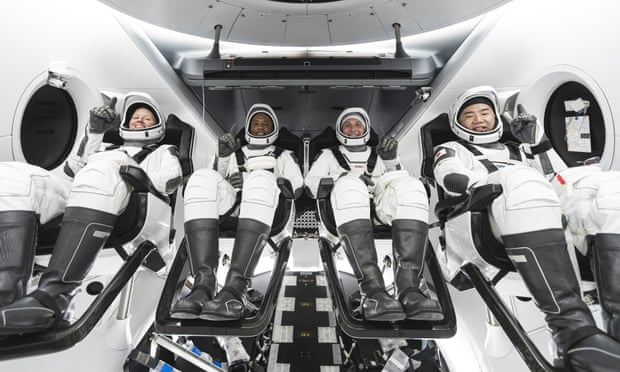The Falcon rocket thundered into the night from Kennedy Space Center in Florida with three Americans and one Japanese onboard, the second crew to be launched by SpaceX. The Dragon capsule on top – named Resilience by its crew in light of this year’s many challenges, most notably Covid-19 – is due to reach the space station after 27-and-a-half hours and remain there until spring.
SpaceX founder and chief executive Elon Musk was forced to monitor the action from afar after being sidelined by the virus. He tweeted that he “most likely” had a moderate case of Covid-19. Nasa policy at Kennedy Space Center requires anyone testing positive for coronavirus to quarantine and remain isolated.
Sunday’s launch comes just a few months after a two-pilot test flight by SpaceX and kicks off what Nasa hopes will be a long series of crew rotations between the US and the space station, after years of delay. More people means more science research at the orbiting lab, officials said.
“This is another historic moment,” Nasa administrator Jim Bridenstine said on Friday. But he noted: “Make no mistake: Vigilance is always required on every flight.”
The flight to the space station should be entirely automated, although the crew can take control if needed.
Four hours after liftoff, Nasa announced that it was investigating “an issue with propellant heaters and continuing to gather data”. Half an hour later, Nasa tweeted: “Teams are troubleshooting propellant heaters that heat the fuel aboard Crew Dragon. Temperatures remain stable and the crew remains safe.”
The role of the propellant heaters is to keep the fuel above 60F, according to CBS space journalist William Harwood.
By around five hours after liftoff, the issue had been resolved, as had a problem with the Thermal Control System, which was running slightly too cold.
With Covid-19 still surging, Nasa continued the safety precautions put in place for SpaceX’s crew launch in May. The astronauts went into quarantine with their families in October. All launch personnel wore masks, and the number of guests at Kennedy was limited. Even the two astronauts on the first SpaceX crew flight stayed behind at Johnson Space Center in Houston.
Vice President Mike Pence, chairman of the National Space Council, travelled from Washington to watch the launch.
Nasa worried a weekend liftoff – coupled with a dramatic nighttime launch – could lead to a superspreader event and urged crowds to wear masks and maintain safe distances. Similar pleas for SpaceX’s first crew launch on 30 May went unheeded.
The crew – comprising three men and one woman, led by Commander Mike Hopkins, an Air Force colonel – named their capsule Resilience in a nod not only to the pandemic, but also racial injustice and contentious politics. It’s about as diverse as space crews come, with physicist Shannon Walker, as well as Navy Commander Victor Glover, the first Black astronaut on a long-term space station mission, and Japan’s Soichi Noguchi, who became the first person in almost 40 years to launch on three types of spacecraft.
They rode out to the launch pad in Teslas after exchanging high-fives and embraces with their children and spouses, who huddled at the open car windows. Musk was replaced by SpaceX president Gwynne Shotwell in bidding the astronauts farewell.
The Dragon capsule is quite spacious – it can carry up to seven people. Previous space capsules have launched with no more than three. The extra room in the capsule was used for science experiments and supplies.
The four astronauts will be joining two Russians and one American who flew to the space station last month from Kazakhstan.
The first-stage booster – which landed on an ocean platform several minutes after liftoff – is expected to be recycled by SpaceX for the next crew launch, scheduled for the end of March. That would set up the newly launched astronauts for a return to Earth in April. SpaceX plans to launch yet another crew several months after that.
SpaceX and Nasa wanted the booster recovered so badly that they delayed the launch attempt by a day, to give the floating platform time to reach its position in the Atlantic over the weekend following rough seas.
AP
















































